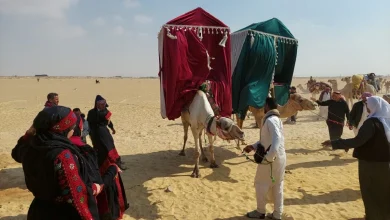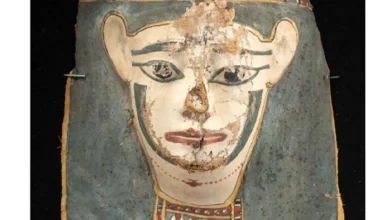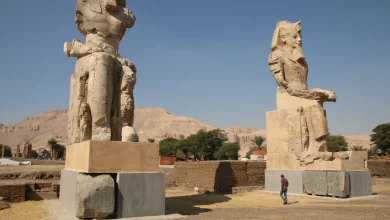The last cow plow in Awamiya…Ahmed Al-Najjar protects the memory of the land from the advance of tractors
At six in the morning, Ahmed Abdo Al-Najjar, 67, sets off on his cart, carrying his old wooden plow. Behind him walk two brown cows, the real engine of this plow that resists the passage of time. Ahmed arrives at the field, carefully unloads his tools, and ties the yoke around the cows’ necks with unerring skill, and they stand quietly, as if they know that it is time to work. On the other side stands Nasser Abdel Hadi, the landowner, carrying a bucket full of corn seeds.
Manual farming
His old blue jilbab clings to his thin body, and he has a light white moustache and small eyes that shine with a strange satisfaction. His cracked hands, like thirsty earth, hold the ropes and tools with confidence. He moves quietly and tenderly, as if each stroke of the plow is a loving touch on the earth.
Ahmed gently ties the yokes to the cows’ necks and pats their backs like a father talking to his children. Then he pulls the ropes with a firmness he knows well. Ahmed al-Najjar is the last person to work with a cow-drawn plow in the Awamiya region south of Luxor. He inherited the profession from his father and grandfather, and his family has been famous for it for decades.

Last of his line
“I love my work very much and I am proud of it,” says Ahmed as he tightens the ropes. “It’s not just a livelihood, it’s a story and an extension of my ancestors’ heritage. More than thirty years ago, the scene was completely different. There were few tractors, and plowing the land with oxen was the norm. There were dozens of workers in every village. But today, there is only one ox plow left in the whole country, and soon we won’t even have that.”
The reason is that the work is exhausting and slow, and the financial return is limited. Ahmed points out that it takes one to two hours to plow a qirat of land, depending on the type of soil, while a tractor can do it in five minutes.
He continues, “I earn 50 pounds, while the tractor driver earns 60, but cow plowing is better for agriculture because it turns the soil slowly and digs it well. With crops such as corn, the seeds need to be sufficiently covered. But the tractor cannot control where the seeds go or how deep they go.”
He adds that the tractor presses down on the soil because of its heavy weight, which sometimes prevents the seeds from growing well. The ox plow, on the other hand, leaves the soil open and balanced.
Nasser agrees, saying, “After Ahmed plows, the water is absorbed well by the soil and doesn’t collect on the surface like it does with the tractor. Without Ahmed, I wouldn’t be able to plant with the same confidence. The tractor is fast, but it suffocates the soil. Ahmed knows every inch of the field, and his plow breathes life into it.”
Ahmed continues to draw parallel lines with precision, followed by Nasser who scatters the seeds, then Ahmed returns to gently cover them. “It takes time at first, but it saves effort later.”
A battle against time and training the cows
Ahmed continues: “Apart from the physical effort, training the cows themselves is hard work. It takes at least three months for a cow to learn how to plow. You have to know your voice, your signals, when to walk and when to turn, and how to work left and right. If you rush or get scared, all the lines will be ruined.” Keeping two cows in good health also requires daily feed and care, which are additional costs that have led many to leave the profession.
Ahmed sighs and says, “I tried to teach my son this job, but he refused. He told me it’s hard work and doesn’t put food on the table. When I die, they’ll throw the plow on the roof.”

A Pharaonic legacy struggling to survive
Since Pharaonic times, the Nile Valley has been associated with animal plowing; the inscriptions on the walls of temples still tell the story of farmers driving oxen through the flood silt. Although mechanization has changed the face of the Egyptian countryside, this legacy is still present in some villages, albeit gradually disappearing.
Between diesel and feed
The comparison between tractors and oxen plows is not limited to time alone. With the rise in diesel prices, tractor rental costs increase during peak seasons. Ahmed’s wages remain relatively stable, but he still has to cover the ongoing costs of feeding and caring for his two cows. He comments: “The diesel runs out. The farmer comes back and says, ‘Come and finish the two acres with the old one.
Heritage expert
Dr. Mohamed Imam, a heritage researcher, says that the cow plow is not just an old tool. It is a symbol of agricultural identity in Upper Egypt and a living extension of Pharaonic farming methods, which relied on harmony between humans, animals, and the land. “Unfortunately, these tools are now disappearing amid the dominance of modern mechanization. Yet they could be an important tourist and cultural attraction.”
Imam adds: “Luxor attracts tourists from all over the world who come to see the history of the pharaohs. Ahmed al-Najjar’s plow could become a tourist attraction. Visitors could see the ancient plowing experience for themselves. This is a living heritage that is no less important than temples and monuments, because it connects the past and the present.”
He suggests documenting Ahmed’s plow and tools using 3D technology and adding them to a digital archive documenting traditional agricultural tools in Luxor, to serve as a reference for schools and educational tourism programs.
Read also
Two sculptors from Luxor establish the first school and exhibition to revive Pharaonic sculpture
“Walking Together”: when children and grandmothers dance together in Luxor





Hi, this is a comment.
To get started with moderating, editing, and deleting comments, please visit the Comments screen in the dashboard.